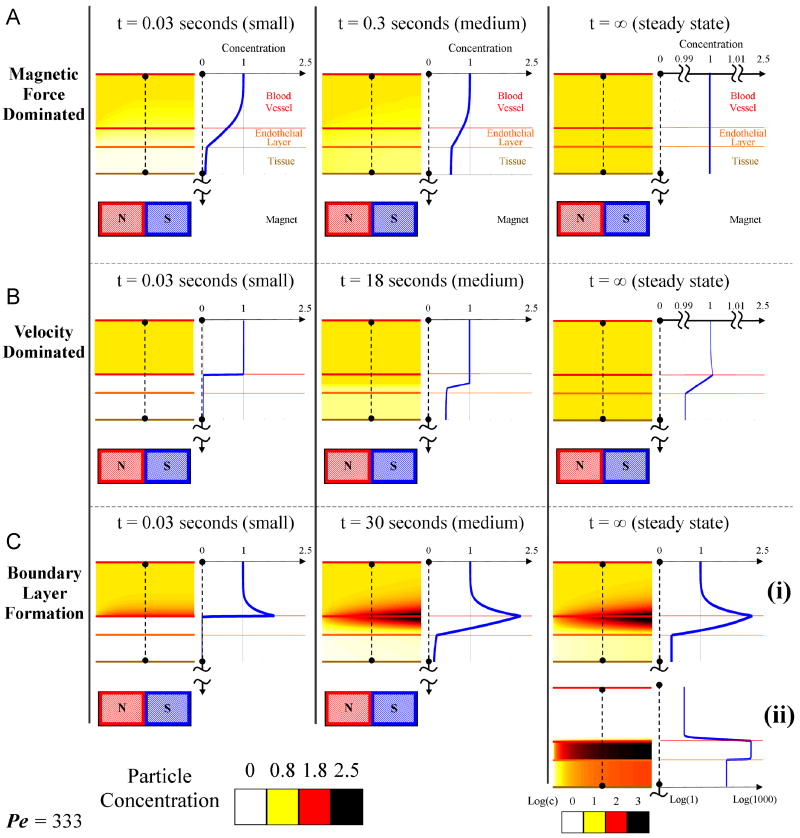Figure 4.
The three prototypical behaviors: A) magnetic force dominated case (Ψ = 10-3,  = 1), B) velocity dominated case (Ψ = 10-5,
= 1), B) velocity dominated case (Ψ = 10-5,  = 10-3), and C) boundary layer formation (Ψ = 10-2,
= 10-3), and C) boundary layer formation (Ψ = 10-2,  = 10-3). (A) The magnetic force dominated case shows a cross-sectional concentration of the magnetic nano-particles for three times at t = 0.03 seconds (early), 0.3 seconds (middle), and at equilibrium, at Pe = 333. Particles are pulled towards the magnet and out through the bottom of the tissue resulting in a constant concentration equal to the blood inlet concentration. Here the tissue diffusion is set to equal the diffusion in the endothelial membrane. (B) Velocity dominated shows a cross-sectional concentration of the magnetic nano-particles for three times at t = 0.03 seconds (early), 18 seconds (middle), and at equilibrium, at Pe = 333. Particles are washed out before they generate a significant boundary layer along the vessel wall. At long times diffusion equilibrates the concentration between tissue and blood. Here the tissue Renkin number is set at
= 10-3). (A) The magnetic force dominated case shows a cross-sectional concentration of the magnetic nano-particles for three times at t = 0.03 seconds (early), 0.3 seconds (middle), and at equilibrium, at Pe = 333. Particles are pulled towards the magnet and out through the bottom of the tissue resulting in a constant concentration equal to the blood inlet concentration. Here the tissue diffusion is set to equal the diffusion in the endothelial membrane. (B) Velocity dominated shows a cross-sectional concentration of the magnetic nano-particles for three times at t = 0.03 seconds (early), 18 seconds (middle), and at equilibrium, at Pe = 333. Particles are washed out before they generate a significant boundary layer along the vessel wall. At long times diffusion equilibrates the concentration between tissue and blood. Here the tissue Renkin number is set at  = 10
= 10  which means it is ten times as easy for particles to diffuse through tissue than through the endothelial membrane. (C) Boundary layer formation shows a cross-sectional magnetic nano-particle concentration for three times at t = 0.03 seconds (early), 30 seconds (middle), and at equilibrium, at Pe = 333. (i) The steady state profile for Ψ = 10-2. Here the particle concentration is shown on the same linear scale as in other time snap shots. (ii) The steady state profile for a higher magnetic-Richardson number, for Ψ = 10-1. Here both the particle conentration and the cross-sectional plot are shown on a log scale. In both boundary layer cases (Ψ = 10-2 and 10-1) the particles build-up along the vessel membrane on both the vessel side and within the membrane. The boundary layer forms very rapidly. In (ii) the membrane particle concentration is sufficiently high to cause a concentration in the tissue greater than the vessel inlet concentration. In both (i) and (ii) the tissue Renkin number is set at
which means it is ten times as easy for particles to diffuse through tissue than through the endothelial membrane. (C) Boundary layer formation shows a cross-sectional magnetic nano-particle concentration for three times at t = 0.03 seconds (early), 30 seconds (middle), and at equilibrium, at Pe = 333. (i) The steady state profile for Ψ = 10-2. Here the particle concentration is shown on the same linear scale as in other time snap shots. (ii) The steady state profile for a higher magnetic-Richardson number, for Ψ = 10-1. Here both the particle conentration and the cross-sectional plot are shown on a log scale. In both boundary layer cases (Ψ = 10-2 and 10-1) the particles build-up along the vessel membrane on both the vessel side and within the membrane. The boundary layer forms very rapidly. In (ii) the membrane particle concentration is sufficiently high to cause a concentration in the tissue greater than the vessel inlet concentration. In both (i) and (ii) the tissue Renkin number is set at  = 10
= 10  which means it is ten times as easy for particles to diffuse through tissue than through the endothelial membrane.
which means it is ten times as easy for particles to diffuse through tissue than through the endothelial membrane.

